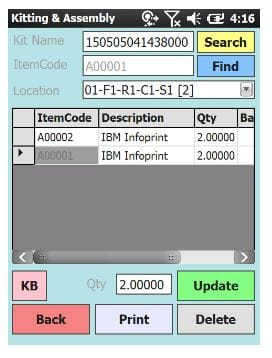Merry Christmas from The RIC Group21/12/2016 We wish you a Merry Christmas and a prosperous New Year.
2016 has seen another year of global growth and expansion for The RIC Group and we thank all our customers for being part of the journey. Our mission is to always exceed client expectations by being friendly, flexible, innovative and provide excellent value for money. The RIC Group's office will be closed from 3pm on 23rd of December 2016 to 9.00am on January 9th 2017. During this time, we will have a skeleton crew operating, so for any support queries please email all support to [email protected] If you have any new purchase orders or sales queries please send to [email protected] SBO4 PDA has a function called Kitting which gives users the ability to complete licence plating. This is a method of grouping and managing inventory items by pallet. The user packs the pallet by scanning the products onto the pallet. Once complete the user selects complete and the SBO4 PDA software will print a pallet barcode.
Each pallet is assigned a unique Licence Plate Number (LPN)and given a barcode label, which will have the SSCC number. This will allow the warehouse users to scan this barcode label when moving it from bin to bin, or for stocktaking or for scan pick and pack. This ensures efficiency as it is one scan and allows the system to track material with high level precision. The below screenshot shows the user scanning products to make the LPN or Kit. Then the SSCC barcode will print and the user can place onto the pallet. Email us at [email protected] or call us on +61 3 9545 0404 for further information on our Warehouse Management Solution for SAP Business One, Sage 300, MYOB Advanced and Acumatica. Barcoding9/12/2016 Since The RIC Group was established in 2001 almost every day we have received enquiries from prospects wanting to start barcoding. One of the most common business needs is to have a solution to print barcodes for the stock items. Our solution Labels4 allows customers to do this. It works with MYOB AccountRight Live, MYOB EXO, MYOB Advanced, SAP Business One and Sage 300.
Our Labels4 product uses a Zebra barcode printer to print barcode labels for stock items, bin locations and delivery labels. Most of the Zebra printers we use are ethernet connection which allows our customers to print from our software no matter where it is installed. This includes when customers have a on cloud or on premises ERP our Labels4 solution still allows users to print the barcode labels from a PC they have at the warehouse. As we have had to help customers implement barcoding for their products in a number of industries such as food with catch weight or medical industry with batch and serial numbers we have knowledge about all the standards which are used such as GS-1, UPC, SSCC, EDI and HIBC. With this we have had also had to gain knowledge in a number of barcode fonts with our Labels4 product such as Code 128, GS-1 13, ITF-14, GS1 DataMatrix, GS-1 128, UPC 8, UPC 12, GS-1 8, GS1 QR Codes. One of the most important parts to barcoding is ensuring the barcodes can be scanned efficiently. Most barcodes need to be achieving a 99.99% scan rate. When using a barcode scanner there are different configurations such as laser, 1D and 2D. The reason we use a barcode printer such as a Zebra GK 420d is to ensure the barcode which is printed is of high quality. Because we know at the next process is the barcode being scanned and it needs to be scanned for several processes such as stocktaking or scan picking or bin transfers. You can't have users of a warehouse management solution getting frustrated with the barcode not scanning and wasting time. This is a reason I would recommend printing barcode labels to a purpose barcode printer rather than to an A4 printer. With our Labels4 product it uses Zebra Designer to design the layout of the label, and then this format is used when printing from our Labels4 software. This means the label format uses the actual ZPL (Zebra Printer Language) when printing the label format. It ensures quality for every label printed. Recently a project involved that we print stock labels to a 30mm x 15mm label which is quite small. As the client was only using the barcode for internal use they had an item number which they wanted to print as the barcode. This item number was alpha numeric. When we first started to print the barcode labels, because of the length of the item number the barcode would be quite long and effect the scanning. Therefore we changed the font to a 2D Datamatrix and now the barcode scanning works perfectly. When implementing barcoding always know what the end is in mind. Barcoding can be simple and cost effective and help with identifying products to help with inventory management. Talk to us at The RIC Group to better understand barcoding and see how it can be applied to help your business. Email us on [email protected] or call us on +61 3 9545 0404. |
Archives
June 2024
|
Call Us: +61 466 368 934
- Home
-
Solutions
-
Advanced Logistics
>
- Advanced Logistics for Acumatica
- Advanced Logistics for SAP Business One
- Advanced Logistics for Odoo
- Advanced Logistics for Netsuite
- Advanced Logistics for Business Central
- Advanced Logistics for Sage Intacct
- Advanced Logistics for MYOB Acumatica
- Advanced Logistics for MYOB EXO
- Advanced Logistics for S/4 HANA
- Advanced Logistics for Sage 300
- Advanced Logistics for Tencia
- Advanced Logistics for Oracle Cloud ERP
- Transport Management System
- Last Mile Delivery
- Warehouse 3D Digital Twin
- RFID
- AUTONOMOUS MOBILE ROBOTS
-
Advanced Logistics
>
- Support
- Blog
- Success Stories
- About
- Contact Us


